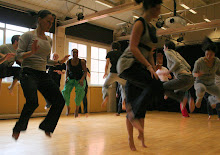1. Discuss the key features of the genre of ‘physical theatre’ as explored in the module content of Process and Performance. (200 words)
‘The characteristics of physical theatre are many and varied. Indeed the term is virtually impossible to define. Yet the emergence of physical theatre […] seems to represent a change in the nature of acting […] and the Stanislavskian notion of interpreting a role.’ (Callery, 2001, p3) During the course of Process and Performance this has been evident. We have been able to construct characters; not only in the conventional theatrical way of embodying a role but by using our bodies, feeling a connection or impulse and pursuing it to create a new character. Many characters have been created by impulse and sensing that connection with other bodies rather than putting pen to paper and researching in depth to create a role in that format.
‘The actor’s instrument, the body, must be well-tuned and able to reflect all the internal and external influences of the dramatic moment.’ (Dennis, 1995, p18) When dissecting this quote; in the genre of physical theatre I would not use the term ‘actor’, but would replace it with ‘performer’, this is because as a performer you are not one dimensional, there are so many different constructive elements that constitute the creation and moulding of a performer must be take into consideration. External influences have been guided by the other bodies in the space and creating a new environment and relationship between the two, this is mainly the physical movements. The internal influences add the intrinsic, innate value to the performance in particular emotions and feelings.
2. What does Ana Sanchez-Colberg imply by the ‘hybrid character’ of physical theatre? Is physical theatre a hybrid performance genre? Discuss with reasons for your answer. (150 words)
“The term itself – ‘physical theatre’ – denotes a hybrid character and is testimony to its double legacy in both avant-garde theatre and dance.” (Sanchez-Colberg in Keefe & Murray; 2007, p 21)
Hybrid can be defined as ‘the offspring of two animals of different breeds, […] as produced through human manipulation for specific genetic characteristics.’ (Dictionary.com, 2008) Colberg implies that physical theatre has been manufactured through physical moulding together of avant-garde theatre (going against the naturalistic) and dance. Yes physical theatre is a hybrid performance . . . it has been formed by the manipulation and mutation of many different areas and it will continue to develop and grow throughout the years. There is that uncertainty that comes with the genre of physical theatre which allows it to be able to take risks, acceptably push boundaries and explore subject matters which would not necessarily be explored everyday; and because it predominantly movement based, the body is allowed to express what would be taboo to express with words.
3. Identify a contemporary British performance company whose practice falls into the remit of ‘physical theatre’ as you have defined in the above two answers. Discuss briefly the key features of their practice that makes them a physical theatre company. (150 words)
“DV8 Physical Theatre’s work is about taking risks, aesthetically and physically, about breaking down the barriers between dance, theatre and personal politics and, above all, communicating ideas and feelings clearly and unpretentiously” (DV8, 2008) This quote correlates with my understanding of physical theatre. DV8 like to push their own boundaries as well as social boundaries and like to experiment with the ‘re-examination the roles and relationships […] in our society’
‘Physicality is central to the actor’s expression: in silence or voice, in motion or stillness.’ (Dennis, 1995, p17) DV8 use of physicality is used to evoke discussion. They use their external influences to their advantage, with their environment specific to the genre they are trying to explore. DV8’s work has that sense of limbo about it, questioning what genre it actually fits into. I would put it under physical theatre, because of it being hybrid. You cannot class it as just dance and you cannot class it as just theatre.
Bibliography:
CALLERY, D. 2001. Through the Body: A Practical Guide to Physical Theatre. London: Nick Hern Books.
DENNIS, A. 1995. The Articulate Body. London: Nick Hern Books.
SANCHEZ-COLBERG, A. 2007. In: KEEFE, J & MURRAY, S. eds. 2007 Physical Theatres: A Critical Reader. London: Routledge
Other Sources
DICTIONARY.COM. 2008. Hybrid [WWW] Available from: http://dictionary.reference.com/browse/hybrid [Assessed 24 February 2009].
DV8 (2008) Artistic Policy [WWW] Available from: http://www.dv8.co.uk/about.dv8/artistic.policy.html [Assessed 24 February 2009]
NICOLE DIXON
skip to main |
skip to sidebar
Welcome to Porto2009.
This is the begining of our journey on the road of Porto2009. And the blog will give us the opportunity as a group to reflect on the work in which we have done within the sessions. We will keep you posted regarding the process we are making along the way.....
Enjoy.
Enjoy.



No comments:
Post a Comment